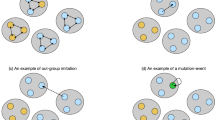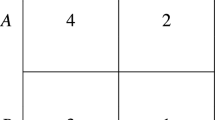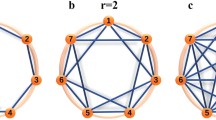Abstract
Tags are conspicuous attributes of organisms that affect the behaviour of other organisms toward the holder, and have previously been used to explore group formation and altruism. Homophilic imitation, a form of tag-based selection, occurs when organisms imitate those with similar tags. Here we further explore the use of tag-based selection by developing homophilic replicator equations to model homophilic imitation dynamics. We assume that replicators have both tags (sometimes called traits) and strategies. Fitnesses are determined by the strategy profile of the population, and imitation is based upon the strategy profile, fitness differences, and similarity in tag space. We show the characteristics of resulting fixed manifolds and conditions for stability. We discuss the phenomenon of coat-tailing (where tags associated with successful strategies increase in abundance, even though the tags are not inherently beneficial) and its implications for population diversity. We extend our model to incorporate recurrent mutations and invasions to explore their implications upon tag and strategy diversity. We find that homophilic imitation based upon tags significantly affects the diversity of the population, although not the ESS. We classify two different types of invasion scenarios by the strategy and tag compositions of the invaders and invaded. In one scenario, we find that novel tags introduced by invaders become more readily established with homophilic imitation than without it. In the other, diversity decreases. Lastly, we find a negative correlation between homophily and the rate of convergence.





Similar content being viewed by others
References
Antal T, Ohtsuki H, Wakeley J, Taylor PD, Nowak MA (2009) Evolution of cooperation by phenotypic similarity. PNAS 106(21):8597–8600
Apicella CL, Marlowe FW, Fowler JH, Christakis NA (2012) Social networks and cooperation in hunter-gatherers. Nature 481:497–501
Axelrod R (1997) The dissemination of culture a model with local convergence and global polarization. J Conflict Resolut 41(2):203–226
Axelrod R, Hamilton WD (1981) The evolution of cooperation. Science 211(4489):1390–1396
Bendor J, Swistak P (2013) Evolution of norms. Am J Sociol 106(6):1493–1545
Berger W, Parker F (1970) Diversity of planktonic foraminifera in deep-sea sediments. Science 168(3937):1345–1347
Bernhard H, Fehr E, Fischbacher U (2004) Group affiliation and altruistic norm enforcement. Am Econ Rev 96(2):217–221
Brechwald WA, Prinstein MJ (2011) Beyond homophily: a decade of advances in understanding peer influence processes. J Res Adolesc 21(1):166–179
Centola D, Gonzalez-Avella JC, Eguiluz VM, Miguel MS (2007) Homophily, cultural drift, and the co-evolution of cultural groups. J Conflict Resolut 51(6):905–929
Dawkins R (1976) The selfish gene. Oxford University Press, Oxford
Durrett R, Levin S (2005) Can stable social groups be maintained by homophilous imitation alone? J Econ Behav Org 57:267–286
Ehrlich P, Levin S (2005) The evolution of norms. PLoS 3(6):e194
Fehr E, Fischbacher U (2002) Why social preferences matter—the impact of non-selfish motives on competition, cooperation and incentives. Econ J 112:C1–C33
Fehr E, Fischbacher U (2003) The nature of human altruism. Nature 452:785–791
Fehr E, Fischbacher U (2004) Third-party punishment and social norms. Evolut Hum Behav 25(2):63–87
Greig JM (2002) The end of geography? Globalization, communications, and culture in the international system. J Conflict Resolut 46(2):225–243
Hamilton WD (1964a) The genetical evolution of social behaviour. I. J Theor Biol 7:1–16
Hamilton WD (1964b) The genetical evolution of social behaviour. II. J Theor Biol 7:17–52
Harper M (2011) Escort evolutionary game theory. Phys D 240:1411–1415
Hastings A (2004) Transients: the key to long-term ecological understanding? Trends Ecol Evolut 19(1):39–45
Helbing D, Johansson A (2010) Cooperation, norms, and revolutions: a unified game-theoretical approach. PLoS One 5:1–15
Hill MO (1973) Diversity and evenness: a unifying notation and its consequences. Ecology 54(2):427–432
Hofbauer J, Sigmund K (1998) Evolutionary games and population dynamics. Cambridge University Press, Cambridge
Hruschka DJ, Henrich J (2006) Friendship, cliquishness, and the emergence of cooperation. J Theor Biol 239:1–15
Jansen V, van Baalen M (2006) Altruism through beard chromodynamics. Nature 440:663–666
Jost L (2006) Phylogenetic diversity measures based on hill numbers. Oikos 113:363–375
Kandel DB (1978) Homophily, selection, and socialization in adolescent friendships. Am J Sociol 84:427–436
Laird RA (2011) Green-beard effect predicts the evolution of traitorousness in the two-tag prisoner’s dilemma. J Theor Biol 288:84–91
Lehmann L, Perrin N (2002) Altruism, dispersal, and phenotype-matching kin recognition. Am Nat 159(5):451–468
Magurran A (2004) Measuring biological diversity. Blackwell Pub, Amsterdam
McNamara JM, Barta Z, Fromhage L, Houston AI (2008) The coevolution of choosiness and cooperation. Nature 451:189–192
McPherson M, Smith-Lovin L, Cook JM (2001) Birds of a feather: homophily in social networks. Annu Rev Sociol 27:415–444
Queller DC (2011) Expanded social fitness and hamilton’s rule for kin, kith, and kind. PNAS 108:10,792–10,799
Rimal RN, Real K (2003) Understanding the influence of perceived norms on behaviors. Commun Theory 13(2):184–203
Rimal RN, Lapinski MK, Cook RJ, Real K (2005) Moving toward a theory of normative influences: how perceived benefits and similarity moderate the impact of descriptive norms on behaviors. J Health Commun 10:433–450
Riolo R, Cohen M, Axelrod R (2001) Evolution of cooperation without reciprocity. Nature 414:441–443
Rogers EM (2010) Diffusion of innovations. Simon and Schuster, New York
Shannon CE (1948a) A mathematical theory of communication. Bell Syst Tech J 27(3):379–423
Shannon CE (1948b) A mathematical theory of communication. Bell Syst Tech J 27(4):623–656
Simpson EH (1949) Measurement of diversity. Nature 163:688
Skyrms B (2004) The stag hunt and the evolution of social structure. Cambridge University Press, Cambridge
Sugden R (1986) The economics of rights, co-operation and welfare. Blackwell, Oxford
Tanimoto J (2007) Does a tag system effectively support emerging cooperation? J Theor Biol 247:756–764
Taylor PD, Jonker LB (1978) Evolutionary stable strategies and game dynamics. Math Biosci 40(1):145–156
Traulsen A, Nowak MA (2007) Chromodynamics of cooperation in finite populations. PLoS One 2:1–6
Traulsen A, Schuster HG (2003) Minimal model for tag-based cooperation. Phys Rev E 68:1–8
van de Waal E, Borgeaud C, Whiten A (2013) Potent social learning and conformity shape a wild primate’s foraging decisions. Science 340:483–485
Weibull J (1995) Evolutionary game theory. The MIT Press, Cambridge
Author information
Authors and Affiliations
Corresponding author
Appendix: Games
Appendix: Games
The following background describes the Snowdrift, Prisoner’s Dilemma, and Stag Hunt games. For simplicity in the work above, we alter payoff matrices so that the games are in terms of one parameter, \(\kappa = c/b\).
Imagine that two people, who will be the players in this game, are driving along a highway during a blizzard. They careen off of the road into a Snowdrift. Snow must be shovelled away from the vehicle so that it may continue its journey. Each player has the choice to step outside and shovel away the snow or remain in the vehicle. If at least one of the players cleans away the snow, then they both can reach home, thereby receiving the benefit, b. If no one does, they receive a payoff of 0. Snow shovelling is exhausting; therefore, there is a cost, c, to shovelling. This energy cost decreases the overall payoff. If both players shovel, then they split the cost; if only one shovels, then that player suffers the entire energy cost. There are three Nash equilibria: (Shovel, Don’t Shovel), (Don’t Shovel, Shovel), and one mixed strategy. However, the ESS for this game is the internal equilibrium. The following payoff matrix represents this game:
where \(b>c>0\).
In the Prisoner’s Dilemma we have two players that choose from a strategy set of cooperate and defect. Let \(b>c>0\). If both cooperate, they receive the socially optimal payoff, \(b-c\). If one cooperates and the other defects, the cooperator earns \(-c\), and the defector earns b, the temptation. If both defect, they each receive nothing. The payoff matrix for this game is:
The socially optimal outcome of cooperation is unstable. At the ESS, the population is entirely composed of defectors.
Consider two hunters, the players, who have the choice between hunting a stag or a hare. Cooperation is required to successfully harvest a stag and receiving the benefit, b; if only one player hunts stag, then that player will fail at catching anything. Hunting stag requires an investment of c regardless of the success. A player who hunts hare will receive a payoff of 0 regardless of the strategy decision of the other player. Again, we have that \(b> c > 0\). The payoff matrix for this game is:
There are two ESSes for this game: all Stag Hunting or all hare hunting. The internal equilibrium is unstable.
Rights and permissions
About this article
Cite this article
Morsky, B., Cressman, R. & Bauch, C.T. Homophilic replicator equations. J. Math. Biol. 75, 309–325 (2017). https://doi.org/10.1007/s00285-016-1083-4
Received:
Revised:
Published:
Issue Date:
DOI: https://doi.org/10.1007/s00285-016-1083-4




